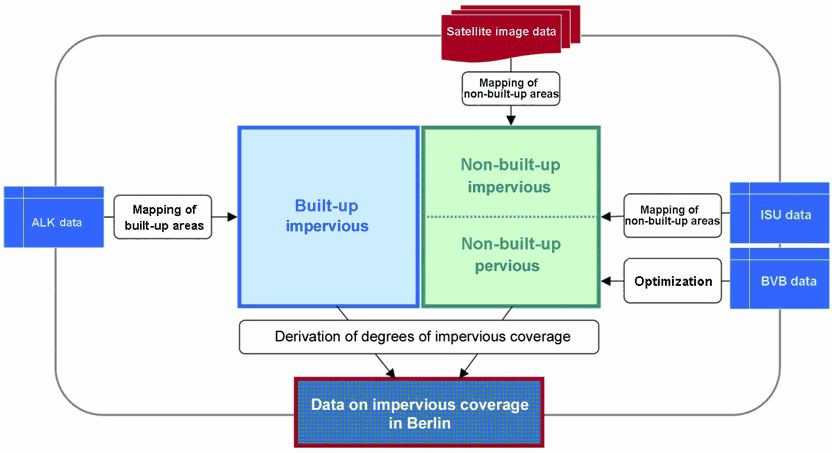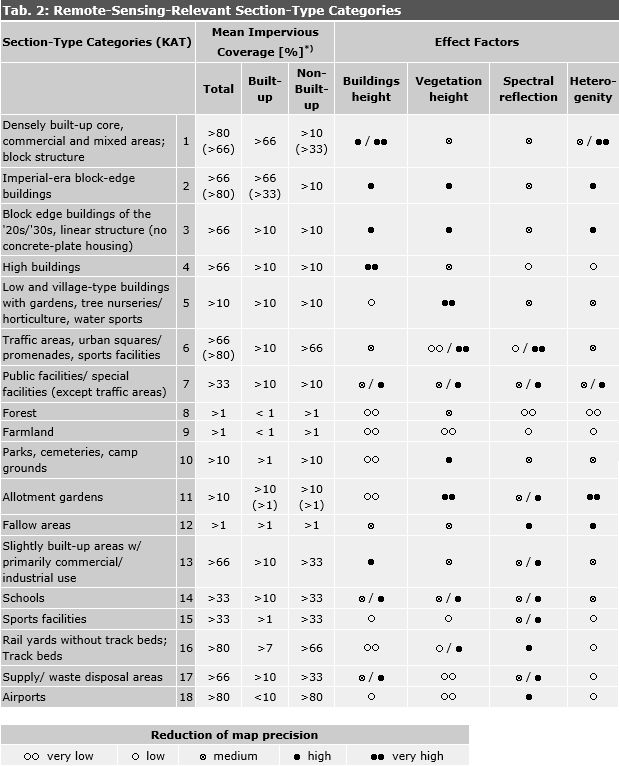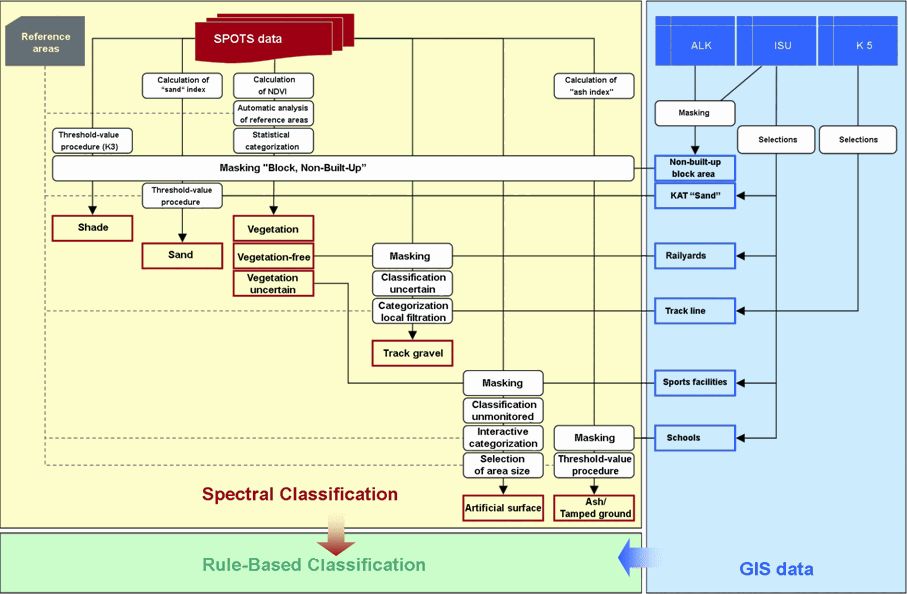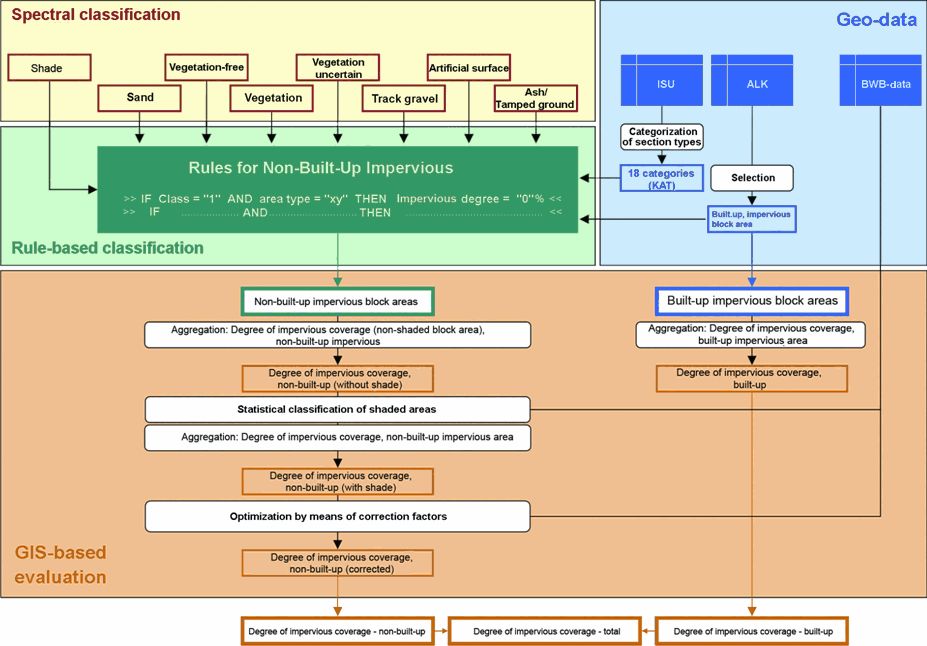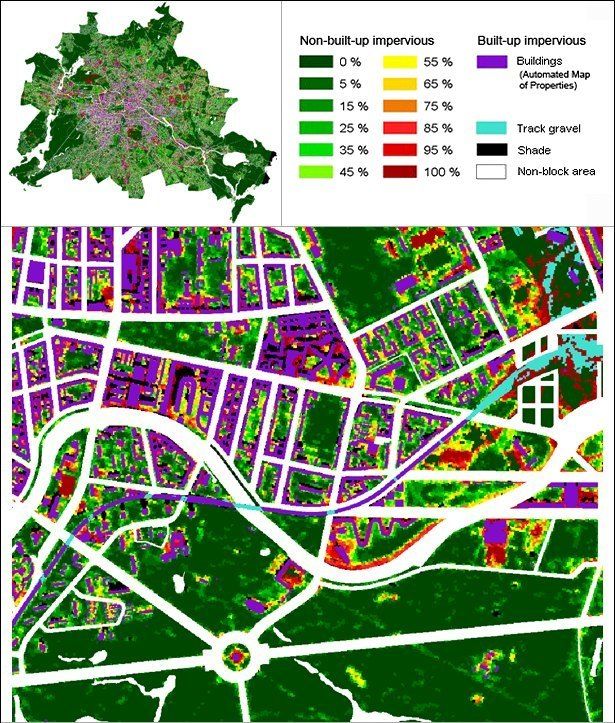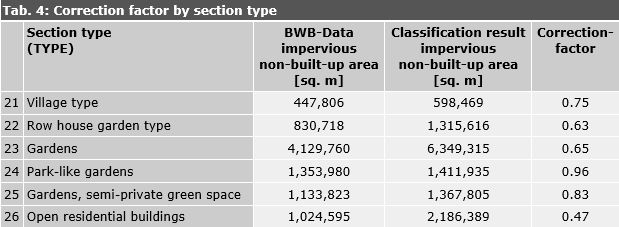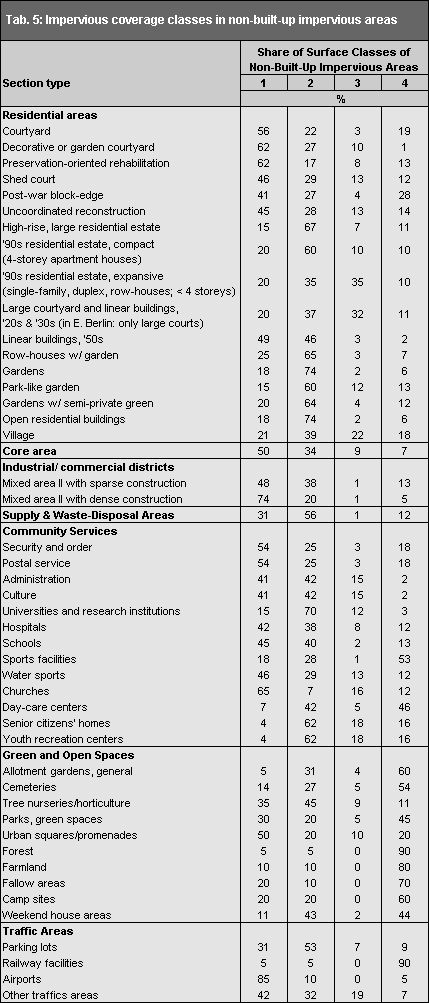Validation of the Satellite-Data Evaluation
A validation method was carried out within the context of the project, the results of which had already been taken into account during the development of the procedure. It quantified the general sensitivity and reproducibility of the procedure in case of transfer to other data sets and ascertainment times.
Two SPOT5 scenes were used for the validation process. The basic development of the procedure, including the calculation of the result, was carried out with the data from a scene from 2005. This procedure was applied to a scene from 2006, adaptations of the method carried out, and cross-scene sensitivity and reproducibility were examined and assessed.
Results and their Effects on the Hybrid Procedure
The basic data for the selection of the validation scene were purposely selected as highly contrary to those of the work scene, to maintain a high degree of external influences. Nevertheless, a good level of agreement of degrees of impervious coverage was ascertained for the reference block areas between the two points in times. The developed methodology is thus well suited for extrapolations of the impervious coverage mapping procedure.
The low number of absolute inaccuracies are of a procedure-specific nature, and are “transferred” for application to alternative points in times. Relative agreement is accordingly very good.
A confrontation of NDVI values for reference areas of both SPOT5 scenes clearly showed the affect of phenology. Compared with the ascertainment time in June 2006, the generally higher photosynthetic activity in August 2005 resulted in higher NDVI values.
After calibration of the NDVI values and their transfer to NDVI categories, a clear improvement in agreement could be obtained for both years. Thus, the phenological effect was largely compensated for by the use of the section-type categories.
The information gained on the reproducibility of the analysis, and on the spatial and temporal stability, can be used to update the impervious coverage map (monitoring). Of particular significance for the time of ascertainment was the affect of the position of the sun on the overall area affected by shade, and by the effect of the vegetation situation.
The result is that a period from the beginning of June to the end of July is recognized as preferable, in order on the one hand to minimize the shaded proportion of the graphical data and at the same time to be able to depict the vitality maximum of the vegetation.
Precision of the Results
After conclusion of the mapping process, an extensive precision analysis of the degrees of impervious coverage ascertained was carried out. The mapping of the non-built-up impervious areas was verified in a sample method by means of aerial-image analysis. The mapping of the impervious built-up areas was evaluated for how up-to-date the data used from the Automated Map of Properties (ALK) were, as well as for their section-type-specific completeness. The results of the partial mapping processes concluded with in an analysis of the overall mapping at the level of section types.
Mapping of Non-Built-Up Impervious Areas
The verification process concentrated on the precision analysis of the non-built-up block areas mapped by satellite remote sensing. Statistical statements were ascertained both for the level of section-type categories, and for the level of section types. As a basis for the derivation of independent verification data, digital aerial-image material (2004) was consulted.
For the entire urban area, verification areas were taken at random and evaluated via an aerial-image-supported systematic random-sample grid. Various analysis and evaluation methods were used for comparison of the mapping and verification data.
The recording precision of the non-built-up impervious areas depends to a large degree on section type. Approximately half of the section types show a high to very high absolute precision (> 90 %) rate (cf. Table 6).
The deviations and precisions for the various residential building types are very heterogeneous (very low to very high precision rates), and depend to a large degree on the use of the BWB data (shade evaluation, correction factors).
Section types for which no block-specific shade evaluation could be carried out by means of the BWB data are notable for very high absolute deviations, and thus low precision rates. One major reason for mis-mapping is the frequently very small-scale proximity of dwellings and garages with surrounding non-built-up areas.
A closer analysis of section types shows that while particularly those section types with a low mean degree of impervious coverage of non-built-up areas show very low deviations of percentage values (very high precision), they on the other hand show very high deviations in proportion to the degree of impervious coverage. This includes particularly the section types “Forest” (55), “Farmland” (56), “Fallow Areas” (57) and “Railyards without Track Beds” (92) and “Track Beds (exclusive)” (99). Nevertheless, the impervious coverage tendency is reflected fairly precisely by the maps in these largely very extensive block areas.
Section types in which parking lots predominate show high to very high absolute deviations. Parking lots are especially often included in the section types “Camp Sites” (58) and “Water Sports” (15), as well as in the public-utilities types. The area under the trees is usually overshadowed here, so that the degree of impervious coverage is underestimated.
Mapping of Built-Up Impervious Areas
For the recording of the impervious built-up areas, building data from the ALK were used exclusively. In view of how highly up-to-date they were, the ascertainment precision of the impervious built-up areas was generally assumed to be 99 % for those section types which were covered completely by ALK data.
For the section types “Rail Yards without Track Beds “ (92) and “Track Beds (exclusive)” (99) there was only fragmentary ALK information or none at all available, so that no precision assessment of the mapping results was undertaken for these areas, as was also the case for “Allotment Gardens” (section types 34, 35 & 37) for the built-up share of which a general area-wide value was assumed.
Area Weighting and Overall Precision
Since the ascertainment precision for the impervious built-up areas of most section types, 99 %, is very high, while that of non-built-up impervious areas depends on their section type and varies between 75 % and 98 %, the precision for impervious coverage generally lies between these values, and, to be specific, depends on the relationship between built-up and non-built-up impervious areas (cf. Table 6). An overview of the overall precision is shown in the last three columns of Table 6.
A four-step evaluation plan was used to evaluate the precision levels obtained. The distinction by “very low deviation” (very high precision), “low deviation” (high to medium precision), “high deviation” (low precision) and “very high deviation” (very low precision) took the spatial-geometric possibilities and the limits of the satellite sensors used (resolution: 10 m x 10 m) into account.
The evaluation of the precision was carried out by means of the so-called absolute root mean squared error (RMSE) of the degrees of impervious coverage (in % of the respective areas). This does not show the deviation of the mapping results from the verification value, which could be described via the relative RMSE of the impervious area (in sq. m), where the mapping result is placed in relation to the verification result (100 %), regardless of the size of the reference area.
Example: a mapped impervious coverage area of 1 hectare with a verification value of 1.5 hectares yields a difference of 0.5 hectares, for a relative RMSE of approx. 33 %. For the absolute RMSE, the same difference is referred to the block area: for a smaller block area of 10 hectares, an absolute RMSE of 5 % is obtained; for a larger block area of 20 hectares, it is 2.5 %.
Thus, in the context of the precision consideration, the following aspects have to be taken into account:
- If only the absolute RMSE is considered, the mapping of small impervious-coverage areas in very large block areas may yield an overly positive assessment.
- If only the relative RMSE is considered, the absolute area size remains undifferentiated, so that even slight differences between areas already describe extremely large errors, although in most cases, the impervious coverage characteristics will have been correctly recognized.
The Results of Precision Investigation
With the mapping method used, the overall result of the precision assessment of the degree of impervious coverage of Berlin was ascertained with a mean precision rate of approx. 95%.
An overview of the precision levels (cf. Table 6) shows that very densely built-up section types are necessarily mapped with high or very high precision levels, due to their ALK integration (>90 %). Altogether, precision levels of over 90 % are achieved for 49 of the 62 section types.
As expected, lower precision levels are primarily obtained for section types whose overall degree of impervious coverage mainly results from non-built-up areas. For ten section types, the mean precision levels are between 85 % and 90 %.
Very low precision levels were ascertained for three section types (less than 85 %). These were “Camp Sites” (58), “Parking Lots” (91) and “Other Traffic Areas” (94), and their results are due to the insufficient ascertainment of their non-built-up impervious areas. Since the blocks of these section types cover a total area of only approx. 374 hectares citywide, these errors are acceptable.
The overall picture of precision is that in the new hybrid-procedure approach integrating the use of both geo-data and satellite data, the respective advantages of these two information sources are combined.
On the one hand, the built-up areas are as a rule mapped very precisely by means of ALK. On the other, the regular combination of high-resolution satellite-image data with geo-data, the non-built-up impervious areas are ascertained with high precision in most section types.
The tendency to underestimate the degree of impervious coverage of non-built-up impervious areas is also a factor in the calculation of the overall degree of impervious coverage, and is methodologically inherent. Once this procedure has been used widely in the context of monitoring, this effect will be equalized, so that statements concerning changes will become possible at block level.
Adoption of the Surface Types from 2001
The surface types of the non-built-up impervious block segments (walkways, courtyard areas etc.) were grouped into four surface-type classes, from concrete to grass pavers. Their respective distribution was investigated via selected test areas, and the results transferred to all areas of the same section type. The type-specific surface type distribution was not updated for the current map, but is based on a survey from 1988 (AGU Arbeitsgemeinschaft Umweltplanung 1988). The surface types are not shown on the map; however, they can be shown via the factual data display by block area.

